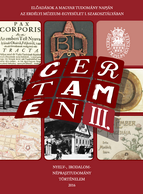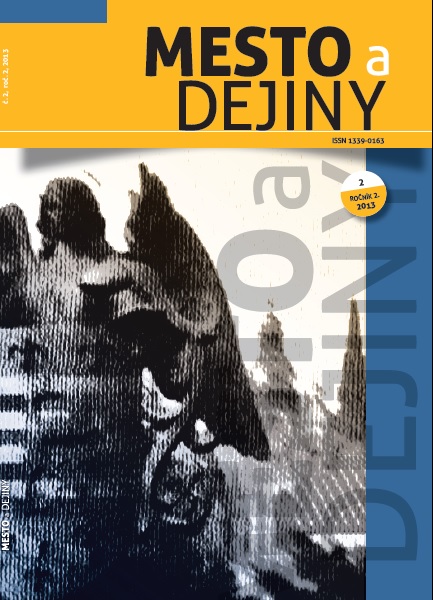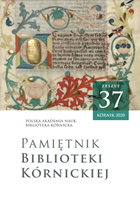
Rövidítésjegyzék és mutatók
The file contains the abreviations used both in the article and in the indexes and the indexes of the names, of the geographical places and of the institutions that are to be found in the articles.
More...We kindly inform you that, as long as the subject affiliation of our 300.000+ articles is in progress, you might get unsufficient or no results on your third level or second level search. In this case, please broaden your search criteria.

The file contains the abreviations used both in the article and in the indexes and the indexes of the names, of the geographical places and of the institutions that are to be found in the articles.
More...
Market towns’ privileges and their system of self-government and administration were similar to the free royal cities. In the late 14th century, Miskolc doubled in size, besides the „Old Town“, the „New Town“ was first mentioned in 1376, with its own weekly fairs and administration, even with a separate parish. The parish church of the New Town, first mentioned in one of the Pope’s deeds in 1445, bore the name of the Holy Virgin Mary as its title. The fact that a cotters’ street or quarter came into being next to the church of the New Town indicates the independence of the New Town and its parish, similarly to the Old Town. The separation of the Old Town and the New Town was a medieval phenomenon, however the dual centres did not survive the Middle Ages, as Miskolc was burnt down by the Turkish troops in 1544. On the ruins of the former parish, a new baroque monastery of the Conventual Franciscans (Minorites) was built in 1720s, and a Minorite scribe made a small drawing in the protocol of the convent showing the outline of the medieval church.
More...
Between Moravia and Prussia there was an important medieval route passing through the economic and political centres (Olomouc, Opava, Raciborz, Krakow and Torun). A very important medieval route existed between Moravia and Prussia, connecting the economic and political centres (Olomouc, Opava, Raciborz, Krakow and Torun). Situation on this road made it possible to research the continuous material and ideological transfer, the existence of which is evident from the archaeological finds in Opava region. We have compiled three thematic groups of artefacts which include utility ceramics, numismatic material, and sacral artefacts used by pilgrims. Within the identified system, various groups of travellers including merchants, artisans, diplomats and pilgrims can be detected.
More...
According to the charter issued by Andrew, Bishop of Eger, the Košice burghers were exempted from jurisdiction of Archdeacon of Abaujvár in 1290. Circumstances connected to its origin and then comparison with other charters containing similar privilege seem to be essential factors leading to better understanding of the source. Hereby a very detailed analysis of the text might say more to explain its meaning. Therefore, the cognoscible context of exemptions with the examination of circumstances leading to the issuance of the charter in 1290, along with consideration of the words written in the text, encourage the opinion that the burghers of Košice had been exempted from jurisdiction of Abaujvár´s Archdeacon even before. The Bishop´s charter seems to be only a confirmation of the right allowed earlier, which was a common phenomenon in the towns (or in the communities of guests) of the Hungarian Kingdom.
More...
The study deals with suburban churches and hospitals in medieval Košice. Author evaluates historiography published on this topic and presents results of detailed research of town books and tax registers. The aim of contribution consists of characterizing of the development, i.e. origins and cessation of the buildings, their approximate geographical location as well as the position in the church administration of Košice. The existence of three churches and two hospitals surrounding the walled town has been proved by the research. The main and also the oldest hospital with a church had patrocinium of the Holy Spirit. It laid in front of the Lower Gate on south. As the second one, the church of St. Ladislaus was erected in the northern suburb. The last such objects built here in the Middle Ages were leprosarium and church of St. Leonard on the west side. In addition to this, there was constructed one more church in the town´s cadaster, staying in the village of Košická Nová Ves.
More...
This contribution describes and evaluates four wells explored or documented in 1990s in the streets of Košice. Two of the wells were investigated in Hlavná Street – one of them is located in the Lower Gate area and the other is near the Immaculata. The third well was researched in Dominikánske Square. The well in front of Kováčska Street 26, damaged by a sewer trench, was documented only. Profile of the wells is round, narrowing towards the bottom. Their construction character is identical as well – stone walls built on a wooden base construction. The maximum difference between the bottoms’ levels is 1.5 m. It was impossible to measure the depth and identify the construction method of the well in Kováčska Street – in front of Kováčska 25, as it was situated under the bottom of the sewer trench backfill. Despite the fact that dating of the wells was not possible, it is undoubtable that they were used in the modern era. They disappeared when the city water supply was built in the beginning of the 20th century.
More...
The paper deals with issues pertaining to the relations and communication between the representatives of the town administrations in Košice, Bardejov and Prešov in the 15th century. The reflection of these relations may be found in correspondence preserved in the archives of these towns. These documents have made the author to note that mutual cooperation was developed among the towns, especially in the field of the town diplomacy by sending common town delegates to the Royal court and high dignitaries of the Kingdom and to the common consultations of the towns. Military aff airs and espionage were another area of cooperation between the towns. If the towns were not directly threatened, in many areas (economy, trade) they acted like rivals. One example is the cause between Bardejov and Prešov because of bleaching linen, lasting for the whole 15th century.
More...
Adakale, a center of Turkish culture in the Balkans since the 15th century, has witnessed the establishment of cultural communication between the Balkan people sharing the multicultural life symbolized by the River Danube. After the “loss” of Adakale by being submerged in 1970, music and literature were the only media reflecting this memory. The past studies of Turkish folk poetry and music compiled from the Adakale region will be evaluated within this work. Possible methods of re-envisioning the melodies of the compiled lyrics whose melodies are lost will be discussed by utilizing compilations made from other regions of the Balkan Peninsula and using the folk melodies in Turkey that originated from the Balkan lands.
More...
There are two Qur’an manuscripts in the collection of the Kórnik Library (Poland) – BK 1716 and BK 2676. Th e fi rst one, dating from the 17th century, is rich in diff erent types of scribal errors and serves as an interesting example of ways of amending them. Th e second one, dating from the 15th century, includes interesting illuminations and calligraphy. Th is paper is a detailed analysis of these manuscripts, including their covers, decorations and scribal errors.
More...

This research presents new insights into the development of mining in Bulgarian territories during the 15th to 17th centuries, drawing from previously unpublished Ottoman Turkish documents. These documents, sourced from the Ottoman Archives at the Presidency of the Republic of Turkey in Istanbul, offer valuable information on various aspects of mining activity. The author highlights a significant contribution to scholarly understanding by introducing, for the first time, details about the presence of kürecis (individuals responsible for melting ore in furnaces) in Bulgarian lands during the late 15th century. Additionally, the study sheds light on the religious affiliations and demographic shifts among kürecis over time, providing a unique perspective on this aspect of mining history. Furthermore, the research uncovers new data regarding the involvement of Voynuks in security functions within the mines, as well as the participation of Müselems and Yürüks in the ore remelting process. These findings contribute to a deeper understanding of the roles and dynamics within the mining industry during the specified period.
More...
In these studies, with the help of unpublished Ottoman tax registers from the group of tapu tahrir defterleri, stored in the funds of the Ottoman Archives in the city of Istanbul, the question of the ways of demographic recovery of the settlements in the Eastern part of the Upper Thracian Lowland in the period 15th – 16th c., a consequence of the military actions conducted in the area in previous centuries. For the realization of the set goal, in addition to the mentioned Ottoman Turkish documents, the achievements of modern historiography on these problems were also used. It was established that the region suffered greatly from the military actions in the period of the 12th – 14th c. At the end of the 15th c., the demographic crisis was overcome as a result of the settled slaves, freed slaves, representatives of various nomadic groups, population from the areas of military actions and the voluntary or forcibly resettled population from other parts of the Ottoman Empire. Examples of both Muslim to- non-Muslim and Christian-to-Christian slavery are presented.
More...
Book review: Penka Danova. Bulgaria and the Bulgarians in Italian historiography (XIV–XVII centuries). Sofia: Institute for Historical Studies, 2023
More...
The Ottoman Empire administered Nis and its surroundings for a very long period, more precisely from 1389 to 1878. Based on Ottoman archival sources, published works, and field studies, many cultural and social monuments of that period come to light. The number of waqf monuments that were built and registered in Serbia, Montenegro, and Sandzak (Novi Pazar) (New Yugoslavia) during the Ottoman period is 1,140. While the number of monuments that have managed to survive until today it is only 30. In Nis alone, it is mentioned that a total of 23 mosques, 2 madrasas, 4 schools, 7 tekkes, 2 public canteens (imaret), an inn, 2 hamams, 3 fountains, a castle, and a bridge have been destroyed. Therefore, the figures given in the paper do not necessarily mean to extract all the monuments of that period, because there are still many documents in different archives that researchers are expected to use in the future in order to complement the historiography, however, we hope that this study will help to fill a part of that gap.
More...
The history of the Ohrid Archbishopric, which researchers have been studying for more than two centuries, is a favourite topic of Slavists (historians, theologians, art historians). In different chronological periods, this Byzantine archbishopric has been the central object of the claims of the Byzantine, Bulgarian and Serbian churches. The importance of the archbishopric also depended on the extent of the territory under its jurisdiction. The function of the archbishopric was ecclesiastical and political. It acted not only as an autocephalous ecclesiastical organization, but also as an institution supporting political structures.
More...
The paper treats the issue on the reconstruction of the image of Tsar Samuel from the perspective of the Ohrid Archbishopric. The snapshots from the sources starting from Basil II’s sigillia and other official acts, reveals that the representation of Samuel was largely shaped in accordance with the ideological concept of the Ohrid Archbishopric. Depending on the political constellation and the momentary aims of the ideological propaganda, Samuel was either recognized as the fundamental ruler and inseparable part of the traditions of the Ohrid Archbishopric, or was completely excluded within the constructed theories about the origin оf the Archbishopric. The leading people in the Ohrid Archbishopric constantly modified and constructed the ecclesiastical traditions for the purpose of reinforcing the position and the status of the Archbishopric, in which the Christian saints were also exploited. This tendency also found reflection in the alteration of the original legend about Vladimir and Kosara, that served Archbishopric’s pretensions for obtaining the leading role among the Orthodox Christians in the Balkans. Hence, from the reading of the official works composed for or from the Ohrid Archbishopric we can notice the tendency for adapting, constructing and manipulating the traditions emerging from Samuel’s political and ideological program, that involved the cults and legends originating in Prespa and Ohrid, wherefrom we receive opposed and distorted images of Samuel. Their deconstruction is the main goal of this paper.
More...
The legacy of the most prominent Bulgarian Church historian, Ivan Snegarov (1882–1971) has not been an object of an extensive and detailed analysis until recently. The article Ivan Snegarov – Life and Historical Work is an attempt to fulfi ll this lack and presents a brief outline of the author’s PhD dissertation with the same title. The article is divided onto three parts: the first one (entitled Life) is a biography of Snegarov, the second (The Various Periods of the Bulgarian History in Ivan Snegarov’s Works) – analysis of his major historical works, and the third (Into the Constructive Laboratory of the Historian Ivan Snegarov) – synthesis of the most essential trends and ideas in Snegarov’s writings.
More...
The archeological site ,,Mal Kayasi“ is located in the area of the village Bansko. It is a Late Antique fortification that was also operational during the Middle Ages. The fortress is located on one of the protruding hills on Mount Belasica, about 0,7 km southwest of the Roman Thermal spa. Some authors, here locates the Termica fortress (Θερμιτζα), which is mentioned in the chronicles of John Skylitzes, as one of the most important fortresses used by Tsar Samuel in the Strumica area. The first archaeological excavations were conducted during 2017, and then during 2019. A small part of the northwestern side of the acropolis was uncovered, where the late Antique fortress is located, as well as a single-nave church, which is located about 70 meters south of the fortress. According to the primary knowledge, this sacral building was built in the 12th–13th century and existed, probably until the Ottoman conquests of this area. It is built of slabs of stone, and lime mortar is used as a binder. The church was covered with frescoes. Two layers of frescoes have been found. A small single-nave church was built for the spiritual needs of the crew in the medieval fortress, or it was part of a small monastery complex.
More...
This article examines the origins and application of the Ottoman agro-fiscal unit known as the “pair of oxen.” Its roots can be traced to the agricultural practices and taxation policies of pre-Ottoman societies, including the Byzantine and Seljuk empires, as well as earlier civilizations such as the Roman and ancient Persian societies. Historically, the pair of oxen served as a benchmark for assessing the productive capacity and wealth of farmers, forming the basis for taxation. The author provides examples illustrating that this system persisted in the Bulgarian lands until the very end of Ottoman rule.
More...